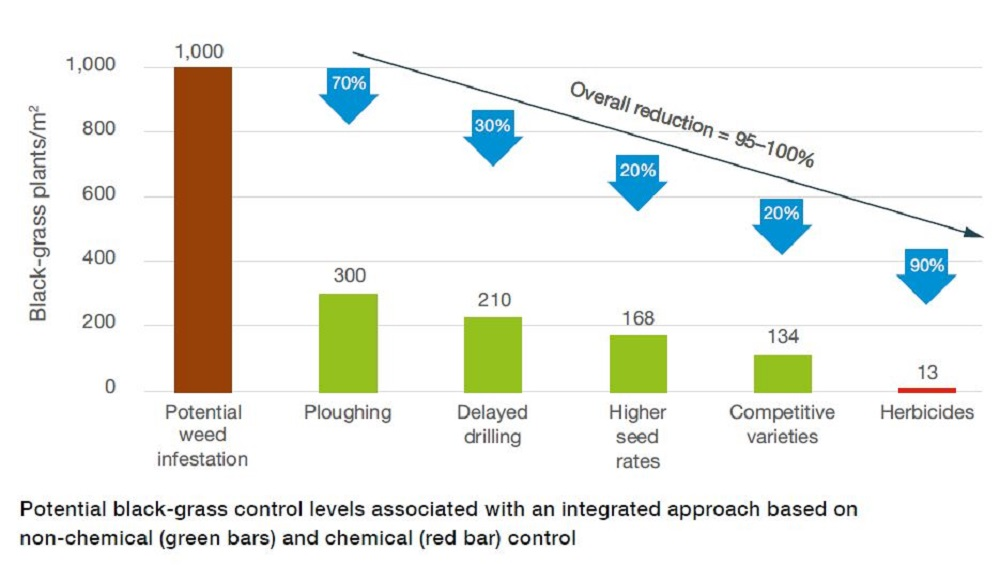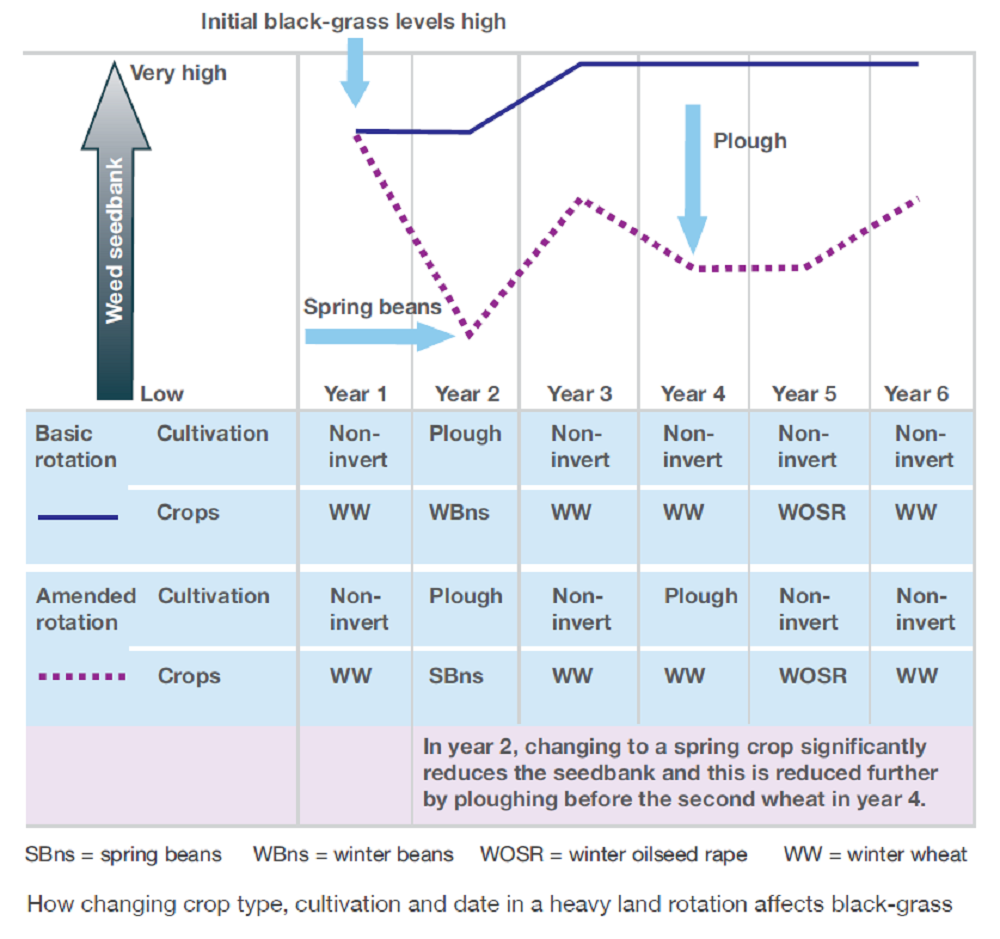- Home
- Knowledge library
- Integrated management of black-grass
Integrated management of black-grass
About 95–100% black-grass control is required to prevent populations increasing. Combine non-chemical control with herbicides to improve overall control and protect efficacy.
How to manage black-grass in arable crops
Integrated black-grass management
There are many non-chemical control methods available. In isolation, none provides complete control. The average levels of control cited on this page are based on a comprehensive review of more than 50 field experiments*.
*P J W Lutman, S R Moss, S Cook and S J Welham (2013), Weed Research, 53: 299–313.
 AHDB
AHDB
Spring cropping (90% control)
About 80% of black-grass emergence occurs in autumn. A spring-sown crop provides a wider window for control during the between-crop period. Some spring-sown crops offer more control than others. For example, spring barley is more competitive than spring wheat, and spring beans and linseed are not as competitive as spring cereals. Note: establishing crops in spring can be difficult, especially on heavy soils, and herbicide choice is more limited.
Fallowing/grass ley breaks (70–80% reduction of the seed bank per year)
Average black-grass seed decline in the soil is about 75% per year. Seed persistence data and farm experience both support the view that a one-year fallow or grass ley is not long enough to reduce high black-grass infestations to acceptable levels. After two years, less than 10% of seeds are likely to remain. This could still be a large number and a longer break may be required. Failure to prevent seed return greatly undermines the value of a fallow or grass ley break. The cultivation strategy at the end of any fallow or grass ley break is important. Sufficient time needs to elapse between cultivating and sowing the next crop to allow the destruction of black-grass seedlings emerging from residual seeds.
Ploughing (70% control)
High-quality ploughing, with good inversion of the furrow, buries seeds to a depth from which seedlings are unlikely to emerge (>5 cm). Black-grass seeds are relatively non-persistent in the seed bank, so ploughing brings few viable seeds to the surface. This is especially true for rotational ploughing (e.g. ploughed once every 3–6 years). No-till and particularly shallow non-inversion tillage tend to favour black-grass, because freshly shed seeds stay near the soil surface. Failure to control black-grass effectively in such systems can result in a much more rapid increase in infestation (more than tenfold per year) than occurs in systems based on annual ploughing.
Delayed autumn drilling (>30% control)
Delayed drilling (until after mid-October) of winter cereals has three main benefits:
- More weed seedlings emerge before sowing for control with cultivations and/or glyphosate.
- Residual pre-emergence herbicides are often 25–30% more effective when applied in later-drilled crops (because soil conditions are more likely to be optimal).
- Late-emerging black-grass tends to be less competitive and produces fewer seeds per plant.
Adequate drilling capacity, including drills for suboptimal soil conditions, is required to minimise the risks associated with delayed drilling. Always aim to drill fields with the heaviest black-grass infestations last.
Competitive crops (<25% control)
Crops can compete with weeds to varying degrees. The following factors can make a crop better able to suppress weeds:
- The right species (e.g. barley is more competitive than wheat)
- High seed rates of winter cereals (e.g. >300 plants/m2)
- Narrow row spacing
- Good seedbeds and agronomy to favour strong, uniform crops
Preventing seed return and spread of resistant seeds
Destroying (spraying with glyphosate or cutting) patches of black-grass in winter wheat in the first week of June will reduce viable seed return. Cutting or spraying earlier or later is likely to be less effective. Destroying crop in the same areas for 2–3 years maximises reductions. Hand-roguing is also feasible at low weed populations. Minimise spread of seeds and plants in combine harvesters, balers, cultivation equipment, straw or manure. Harvest weed-control systems are being tested in UK conditions. Such systems include chaff decks/carts, which deposit seeds in a limited area of the field or use seed crushers to destroy weed seeds (over 90% of them) before residues are returned to the soil.
Whether buying or selling straw, it is important to understand the quality of the product. Distribution of weed seeds, in particular, can be associated with straw use. Be sure you are aware of the risks.
Arable weeds and the role of the rotation
Soil contains many weed seeds – the ‘seed bank’. This increases and decreases, as both weeds and crops set and shed seeds. Management of one weed species influences the quantity of other weed species, positively and negatively. To develop a holistic approach to weed management across the rotation, visit our dedicated area of the website.
Managing weeds in arable rotations – a guide
 AHDB
AHDB

